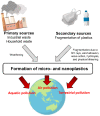Impact of Micro- and Nanoplastics on Mitochondria
- PMID: 36295799
- PMCID: PMC9612075
- DOI: 10.3390/metabo12100897
Impact of Micro- and Nanoplastics on Mitochondria
Abstract
Mitochondria are highly dynamic cellular organelles that perform crucial functions such as respiration, energy production, metabolism, and cell fate decisions. Mitochondrial damage and dysfunction critically lead to the pathogenesis of various diseases including cancer, diabetes, and neurodegenerative and cardiovascular disorders. Mitochondrial damage in response to environmental contaminant exposure and its association with the pathogenesis of diseases has also been reported. Recently, persistent pollutants, such as micro- and nanoplastics, have become growing global environmental threats with potential health risks. In this review, we discuss the impact of micro- and nanoplastics on mitochondria and review current knowledge in this field.
Keywords: environmental contaminants; micro- and nanoplastics; mitochondria; toxicity.
Conflict of interest statement
The authors declare no conflict of interest.
Figures
References
Publication types
Grants and funding
LinkOut - more resources
Full Text Sources




